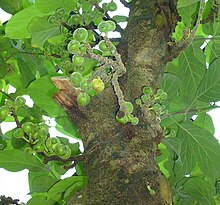Ficus hispida
| Ficus hispida | |
|---|---|

| |
| Scientific classification | |
| Kingdom: | Plantae |
| Clade: | Tracheophytes |
| Clade: | Angiosperms |
| Clade: | Eudicots |
| Clade: | Rosids |
| Order: | Rosales |
| Family: | Moraceae |
| Genus: | Ficus |
| Subgenus: | F. subg. Sycomorus |
| Species: | F. hispida
|
| Binomial name | |
| Ficus hispida L.f.
| |
| Synonyms | |
|
Ficus oppositifolia Roxb. | |

Ficus hispida also known as the Opposite leaf Fig is a small but well distributed species of tropical fig tree. It is dioecious, with male and female flowers on separate individuals.[1] It occurs in many parts of Asia and as far south east as Australia.[2][3] There is a large variety of local common names. Like a number of ficus, the leaves are sandpapery to touch. An unusual feature is the figs which hang on long stems.
Species associated with Ficus hispida[]
In Australia the fruit are eaten by cassowaries and double-eyed fig parrots. Phayre's leaf monkey feeds on the leaves as do the larvae of the moth Melanocercops ficuvorella. The fig wasp Apocrypta bakeri has F. hispida as its host, where it parasitizes the other fig wasp Ceratosolen solmsi. The yet unnamed nematode species Caenorhabditis sp. 35 has been found in Aceh, Indonesia, associated with the tree. Caterpillars of the moth species Asota caricae have been recorded eating F. hispida, the caterpillars skeletonise the leaves.[4]
References[]
| Wikimedia Commons has media related to Ficus hispida. |
- ^ Dev, Suma A.; Kjellberg, Finn; Hossaert-Mckey, Martine; Borges, Renee M. (2011). "Fine-scale Population Genetic Structure of Two Dioecious Indian Keystone Species, Ficus hispida and Ficus exasperata (Moraceae)". Biotropica. 43 (3): 309–316. doi:10.1111/j.1744-7429.2010.00704.x.
- ^ "Ficus hispida". ZipcodeZoo. ZipcodeZoo. Archived from the original on August 30, 2010. Retrieved April 17, 2012.
- ^ "Biotik.org". Ficus hispida. Archived from the original on July 25, 2010. Retrieved April 17, 2012.
- ^ "Asota caricae".
- Ficus
- Trees of China
- Trees of the Indian subcontinent
- Trees of Malesia
- Flora of Western Australia
- Flora of the Northern Territory
- Flora of Queensland
- Trees of Australia
- Trees of Nepal
- Taxa named by Carl Linnaeus
- Dioecious plants
- Moraceae stubs